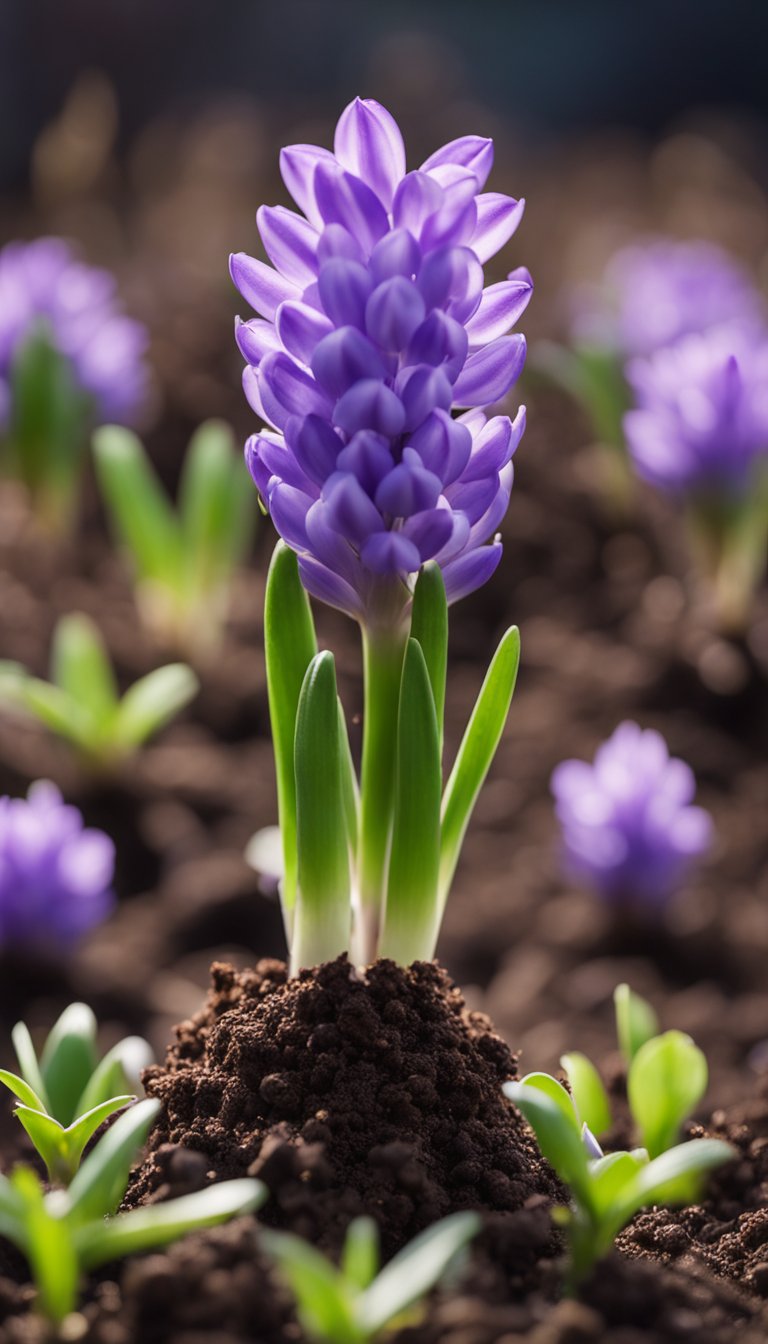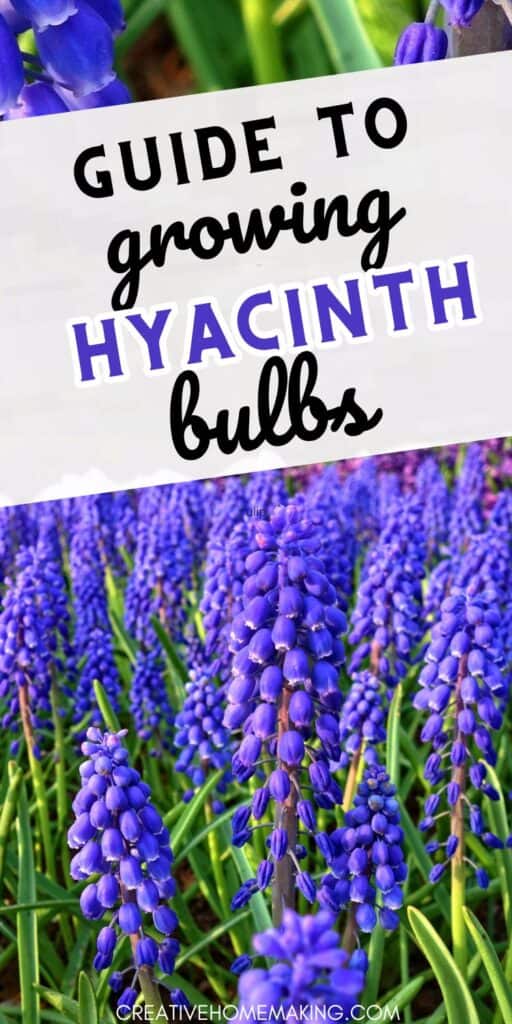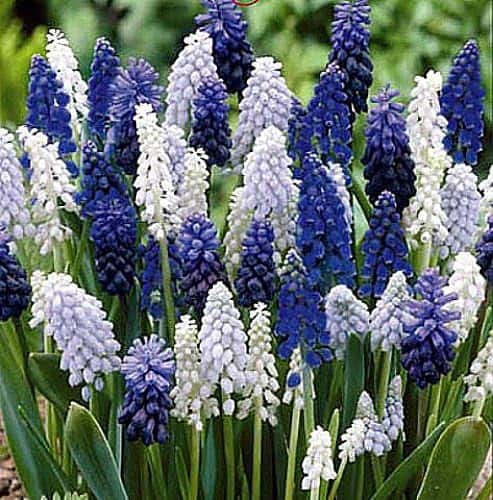If you’re looking for a way to add some color and fragrance to your garden in the spring, growing hyacinth bulbs is a great option.
This post may contain affiliate links.
Hyacinths are a popular choice for gardeners because they produce beautiful, fragrant flowers in a wide range of colors. These bulbs are easy to grow and care for, making them a great choice for both beginner and experienced gardeners.
Hyacinth bulbs can be planted in the fall and will bloom in the spring, providing a burst of color just when you need it most. When planting hyacinth bulbs, it’s important to choose a location that gets plenty of sunlight and has well-draining soil.
Hyacinths prefer soil that is slightly acidic, so adding some peat moss or compost to the soil can help to create the ideal growing conditions. With a little bit of care and attention, you can enjoy beautiful hyacinth blooms in your garden year after year.
Choosing the Right Hyacinth Bulbs
When it comes to growing hyacinth bulbs, choosing the right bulbs is crucial to ensure a successful and vibrant display. Here are some tips to help you select the perfect hyacinth bulbs for your garden.
Understanding Hyacinth Bulb Varieties
Hyacinth bulbs belong to the Hyacinthus orientalis species and are available in a wide range of colors, including yellow, red, white, pink, purple, and blue. There are also many different varieties and cultivars available, each with its own unique characteristics.
When growing hyacinth bulbs, it’s important to consider factors such as bloom time, height, and fragrance. Some hyacinth varieties bloom earlier than others, so if you want a long-lasting display, choose bulbs with varying bloom times.
Additionally, some varieties are more fragrant than others, so if you want to enjoy the sweet scent of hyacinths, be sure to choose bulbs that are known for their fragrance.
Related Article: Growing Daffodils in Pots: Tips and Tricks for a Beautiful Display
Selecting Hyacinth Colors and Fragrances
Hyacinth bulbs come in a wide range of colors, making it easy to find the perfect shade to complement your garden. If you’re not sure which color to choose, consider your existing color scheme and choose bulbs that will complement or contrast with your other plants.
Hyacinths are also known for their fragrant blooms, so if you want to enjoy their sweet scent, be sure to choose bulbs that are known for their fragrance. Some of the most fragrant hyacinth varieties include ‘Delft Blue‘, ‘Jan Bos’, and ‘Pink Pearl’.
Delft Blue Grape Hyacinth Mix 20 Bulbs – Muscari – 8/9 cm Bulbs
Planting Hyacinth Bulbs
Hyacinth bulbs are a popular choice for early spring blooms, and planting them is easy. In this section, we’ll cover when to plant, soil preparation, planting depth, and spacing.
Related Article: Care for Potted Tulips: Tips for Keeping Your Blooms Beautiful
When to Plant Hyacinths
The best time to plant hyacinth bulbs is in the fall, before the ground freezes. This allows the bulbs to establish roots before winter and ensures they will bloom in the spring.
If you missed the fall planting window, you can still plant hyacinth bulbs in early spring, but they may not bloom until the following year.
Soil Preparation
When growing hyacinth bulbs, it’s important to keep in mind that hyacinth bulbs prefer well-drained soil with a pH between 6.0 and 7.0. If your soil is heavy or clay-like, add some sand or compost to improve drainage.
You can test the soil pH with an inexpensive soil pH meter. Before planting, loosen the soil to a depth of 10-12 inches and remove any rocks or debris.
Related Article: When to Plant Flowers for Spring: A Helpful Guide

Planting Depth and Spacing
Plant hyacinth bulbs with the pointed end facing up, about 6 inches deep and 4-6 inches apart. If you’re planting multiple bulbs, space them about 8-10 inches apart. After planting, cover the bulbs with soil and water thoroughly.
To encourage blooms, hyacinth bulbs require a period of cold temperatures, known as “chilling.” If you live in a warm climate or don’t have a cold winter, you can simulate this by placing the bulbs in a refrigerator for 6-8 weeks before planting.
Hyacinth bulbs thrive in full sun to partial shade and are hardy in zones 4-8. With proper planting and care, you can enjoy their fragrant blooms in early spring.
Caring for Hyacinths
Hyacinths are beautiful and fragrant flowers that can be grown both indoors and outdoors. They are easy to care for and can be a great addition to any garden or home. Here are some tips on how to care for your hyacinths:
Watering and Feeding
Hyacinths need to be watered regularly to keep the soil moist. However, it is important not to overwater them as this can cause the bulbs to rot.
A good rule of thumb is to water them once a week, or when the top inch of soil feels dry to the touch. When watering, make sure to water the soil and not the leaves or flowers.

Related Article: Growing Daffodils in Pots: Tips and Tricks for a Beautiful Display
In terms of feeding, hyacinths benefit from a balanced fertilizer that is high in phosphorus. You can use a slow-release fertilizer or a liquid fertilizer every two weeks during the growing season. Be careful not to over-fertilize as this can lead to burned leaves and stunted growth.
Managing Pests and Diseases
Hyacinths are generally not prone to pests and diseases, but they can be affected by aphids, spider mites, and bulb rot.
To prevent aphids and spider mites, you can spray your plants with a mixture of water and dish soap. For bulb rot, make sure to plant your bulbs in well-draining soil and avoid overwatering.
Post-Blooming Care
Once your hyacinths have finished blooming, you can cut off the flower stalks and allow the leaves to die back naturally. This will allow the bulbs to store energy for next year’s growth. You can also fertilize your hyacinths with a high-phosphorus fertilizer to promote bulb growth.
In the fall, you can lift your hyacinth bulbs and store them in a cool, dry place until it is time to plant them again in the spring. Make sure to remove any dead leaves or debris from the bulbs before storing them.
Propagating and Reblooming
If you want to propagate your hyacinth bulbs, you can do so by dividing the bulblets that form around the base of the mother bulb. This is best done in the fall after the foliage has died back.
Gently dig up the bulbs and separate the bulblets from the mother bulb. Make sure each bulblet has some roots attached and plant them in a well-draining soil mix.
Related Article: What to Plant in March: A Guide to Spring Planting
Another way to propagate hyacinths is by forcing them indoors. This involves potting up the bulbs and placing them in a cool, dark place such as a refrigerator for several weeks.
After this chilling period, move the pots to a bright, sunny spot and watch as they grow and bloom indoors. This method is a great way to enjoy hyacinths during the winter months.
Dividing Hyacinth Bulblets
When dividing bulblets, it’s important to handle them gently to avoid damaging the roots. Use a sharp, clean knife to separate the bulblets from the mother bulb.
Make sure each bulblet has some roots attached and plant them at the same depth as the mother bulb. Water thoroughly and keep the soil moist but not waterlogged.
Forcing Hyacinths Indoors
To force hyacinths indoors, start by potting up the bulbs in a well-draining soil mix. Water thoroughly and place the pots in a cool, dark place such as a refrigerator for 12-14 weeks.
After this chilling period, move the pots to a bright, sunny spot and watch as the bulbs grow and bloom. Keep the soil moist but not waterlogged and rotate the pots regularly to ensure even growth.
Whether you’re propagating hyacinths or forcing them indoors, it’s important to provide them with the right conditions for success. Hyacinths prefer full sun to partial shade and well-draining soil.
They also require moderate humidity and regular watering. With a little care and attention, you can enjoy these beautiful, fragrant flowers year after year.
Frequently Asked Questions
What’s the best way to plant hyacinth bulbs in pots?
To plant hyacinth bulbs in pots, you should first fill the pot with well-draining soil. Then, place the bulbs in the soil with the pointed end facing up and the flat end facing down.
Cover the bulbs with soil, leaving the top third of the bulb exposed. Water the soil thoroughly and place the pot in a cool, dark place until the shoots emerge.
Can hyacinth bulbs be grown in water, and if so, how?
Yes, hyacinth bulbs can be grown in water. To do this, place the bulb in a vase or jar filled with water, making sure the bottom of the bulb is just touching the water.
Place the vase in a cool, dark place until the roots start to grow. Once the roots have started to grow, move the vase to a bright, sunny spot and change the water every few days.
What are the steps for growing hyacinth bulbs indoors?
If you want to try growing hyacinth bulbs indoors, you should first choose a pot with good drainage and fill it with well-draining soil. Place the bulbs in the soil with the pointed end facing up and the flat end facing down.
Cover the bulbs with soil, leaving the top third of the bulb exposed. Water the soil thoroughly and place the pot in a cool, dark place until the shoots emerge. Once the shoots have emerged, move the pot to a bright, sunny spot and water regularly.
When is the ideal time to plant hyacinth bulbs outdoors?
The ideal time to plant hyacinth bulbs outdoors is in the fall, around September or October. This allows the bulbs to establish their roots before the winter cold sets in. Make sure to plant the bulbs in well-draining soil and in a spot with good sunlight.
How should hyacinth bulbs be stored when not in use?
Hyacinth bulbs should be stored in a cool, dry place when not in use. Make sure to keep them away from direct sunlight and moisture. You can store them in a paper bag or a mesh bag to allow for air circulation.
Do hyacinths bloom again in subsequent years after the first planting?
Yes, hyacinths can bloom again in subsequent years after the first planting. However, they may not bloom as vigorously as they did the first year. To encourage blooming, make sure to fertilize the soil and provide adequate water and sunlight.
Follow my gardening board on Pinterest.




